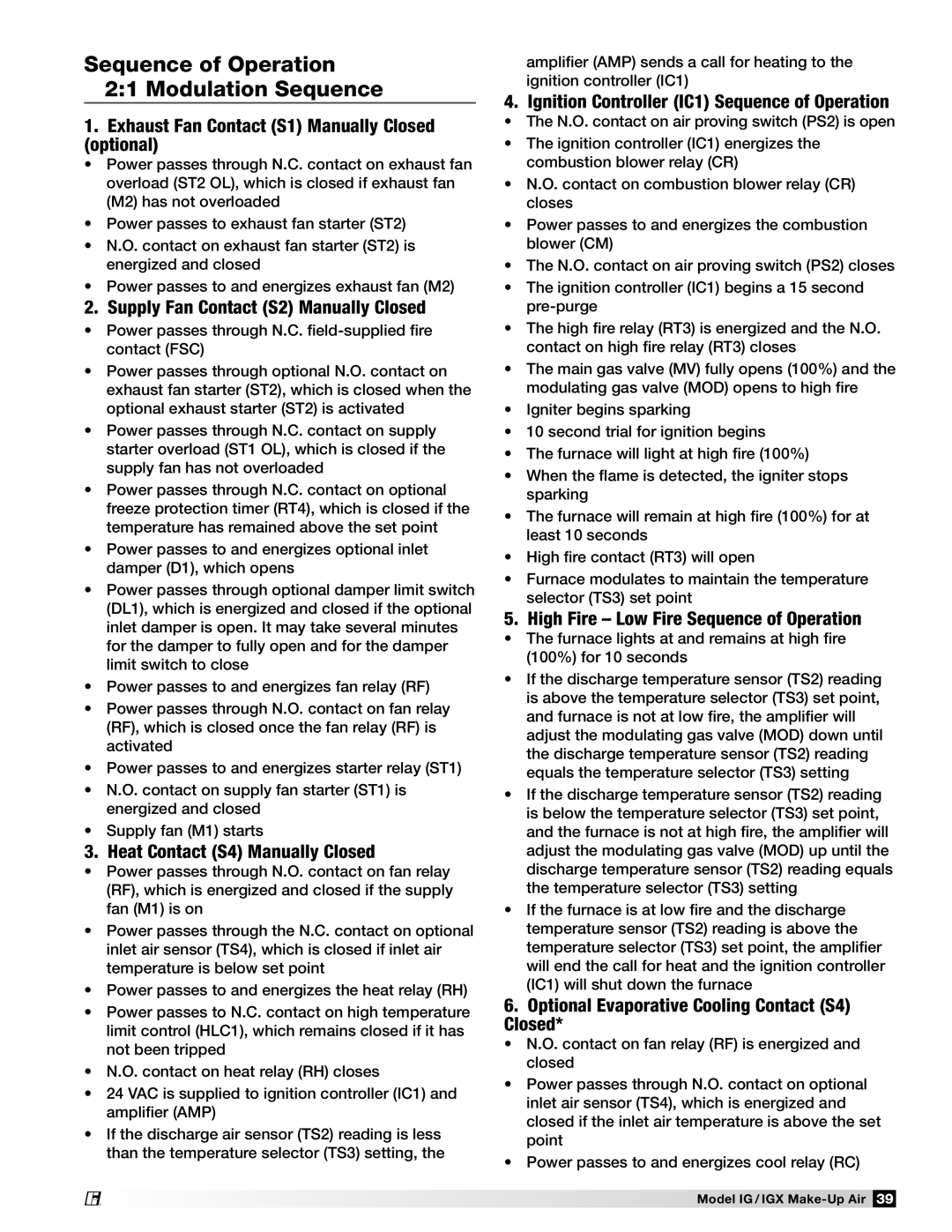
Sequence of Operation 2:1 Modulation Sequence
1.Exhaust Fan Contact (S1) Manually Closed (optional)
•Power passes through N.C. contact on exhaust fan overload (ST2 OL), which is closed if exhaust fan (M2) has not overloaded
•Power passes to exhaust fan starter (ST2)
•N.O. contact on exhaust fan starter (ST2) is energized and closed
•Power passes to and energizes exhaust fan (M2)
2. Supply Fan Contact (S2) Manually Closed
•Power passes through N.C.
•Power passes through optional N.O. contact on exhaust fan starter (ST2), which is closed when the optional exhaust starter (ST2) is activated
•Power passes through N.C. contact on supply starter overload (ST1 OL), which is closed if the supply fan has not overloaded
•Power passes through N.C. contact on optional freeze protection timer (RT4), which is closed if the temperature has remained above the set point
•Power passes to and energizes optional inlet damper (D1), which opens
•Power passes through optional damper limit switch
(DL1), which is energized and closed if the optional inlet damper is open. It may take several minutes for the damper to fully open and for the damper limit switch to close
•Power passes to and energizes fan relay (RF)
•Power passes through N.O. contact on fan relay
(RF), which is closed once the fan relay (RF) is activated
•Power passes to and energizes starter relay (ST1)
•N.O. contact on supply fan starter (ST1) is energized and closed
•Supply fan (M1) starts
3. Heat Contact (S4) Manually Closed
•Power passes through N.O. contact on fan relay
(RF), which is energized and closed if the supply fan (M1) is on
•Power passes through the N.C. contact on optional inlet air sensor (TS4), which is closed if inlet air temperature is below set point
•Power passes to and energizes the heat relay (RH)
•Power passes to N.C. contact on high temperature limit control (HLC1), which remains closed if it has not been tripped
•N.O. contact on heat relay (RH) closes
•24 VAC is supplied to ignition controller (IC1) and amplifier (AMP)
•If the discharge air sensor (TS2) reading is less than the temperature selector (TS3) setting, the
amplifier (AMP) sends a call for heating to the ignition controller (IC1)
4. Ignition Controller (IC1) Sequence of Operation
•The N.O. contact on air proving switch (PS2) is open
•The ignition controller (IC1) energizes the combustion blower relay (CR)
•N.O. contact on combustion blower relay (CR) closes
•Power passes to and energizes the combustion blower (CM)
•The N.O. contact on air proving switch (PS2) closes
•The ignition controller (IC1) begins a 15 second
•The high fire relay (RT3) is energized and the N.O. contact on high fire relay (RT3) closes
•The main gas valve (MV) fully opens (100%) and the modulating gas valve (MOD) opens to high fire
•Igniter begins sparking
•10 second trial for ignition begins
•The furnace will light at high fire (100%)
•When the flame is detected, the igniter stops sparking
•The furnace will remain at high fire (100%) for at least 10 seconds
•High fire contact (RT3) will open
•Furnace modulates to maintain the temperature selector (TS3) set point
5. High Fire – Low Fire Sequence of Operation
•The furnace lights at and remains at high fire
(100%) for 10 seconds
•If the discharge temperature sensor (TS2) reading is above the temperature selector (TS3) set point,
and furnace is not at low fire, the amplifier will adjust the modulating gas valve (MOD) down until the discharge temperature sensor (TS2) reading equals the temperature selector (TS3) setting
•If the discharge temperature sensor (TS2) reading is below the temperature selector (TS3) set point,
and the furnace is not at high fire, the amplifier will adjust the modulating gas valve (MOD) up until the discharge temperature sensor (TS2) reading equals the temperature selector (TS3) setting
•If the furnace is at low fire and the discharge temperature sensor (TS2) reading is above the temperature selector (TS3) set point, the amplifier will end the call for heat and the ignition controller (IC1) will shut down the furnace
6.Optional Evaporative Cooling Contact (S4) Closed*
•N.O. contact on fan relay (RF) is energized and closed
•Power passes through N.O. contact on optional inlet air sensor (TS4), which is energized and closed if the inlet air temperature is above the set point
•Power passes to and energizes cool relay (RC)
®
Model IG / IGX
